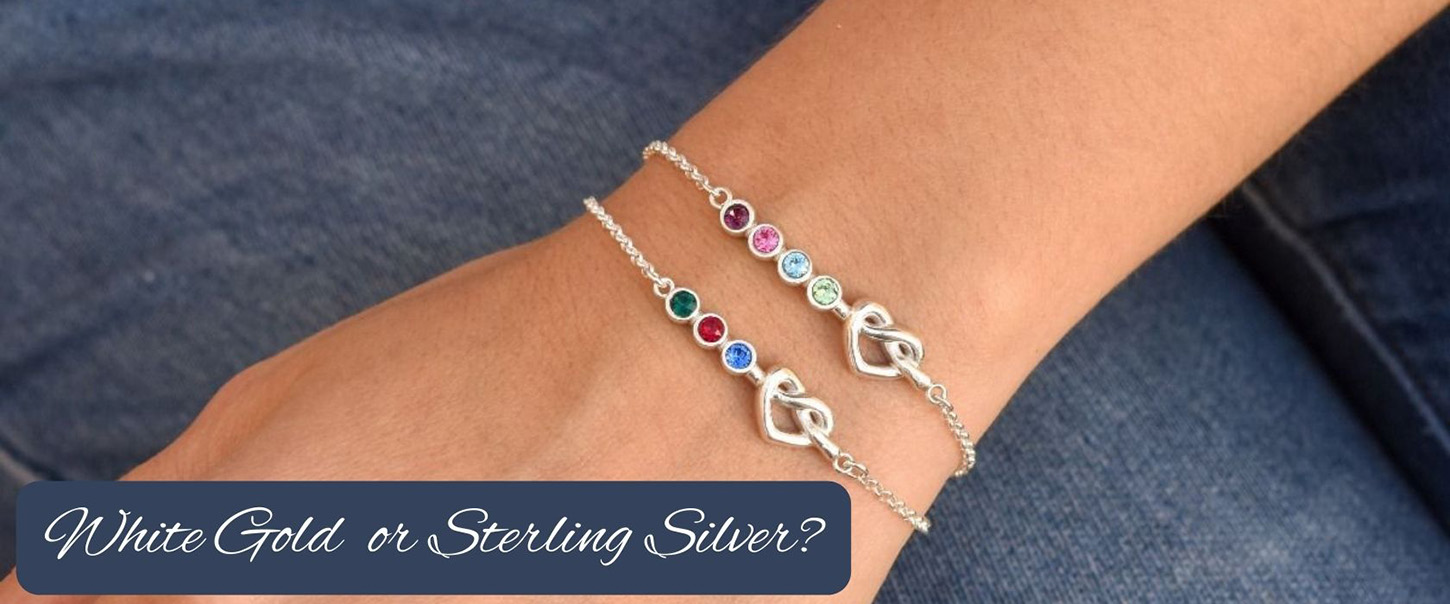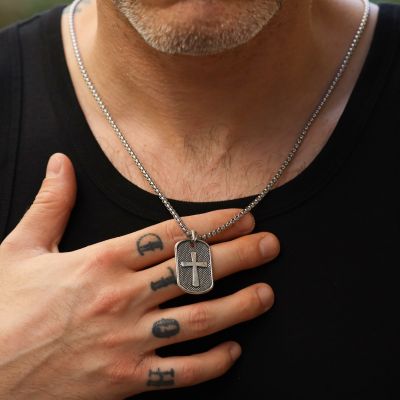Importance of choosing the right metal for jewelry
The metal you choose affects durability, maintenance, aesthetics, and price. Understanding the metal helps you select a piece that aligns with your lifestyle, expressly if you plan to wear it daily.
A brief overview of white gold and silver as popular choices
White gold and silver have long been highly desired. Known for their versatility and varying price points, these metals suit different styles, pieces, and budgets. But what gives them their unique characteristics? Let's delve deeper.
Understanding Composition and Properties
The composition of white gold: metals and alloys
White gold is not naturally occurring. It's an alloy of gold and white metals such as palladium or silver, sometimes with a hint of copper or zinc. It's often coated with rhodium to enhance its whiteness—giving you that shiny, bright luster.
The composition of sterling silver
Fine silver is soft and malleable, which is great for crafting, but not ideal for jewelry. Enter Sterling Silver—92.5% silver and 7.5% copper or other metals. This composition enhances durability without compromising its much-adored shine.
Comparing durability and strength: white gold VS sterling silver
While both metals are used extensively in jewelry, they differ slightly in durability. White gold, with its alloy composition, tends to be more resistant to scratches and tarnish—making it perfect for engagement rings or bracelets. Although sturdy and durable, silver is softer and may scratch over time. But don't worry— minor surface scratches are natural and add a unique patina to your silver pieces.
Aesthetics: Appearance and Color
Color differences between white gold and silver
Freshly polished white gold and silver may look similar, but their colors aren't identical. Due to its gold content, white gold tends to have a slight yellowish hue. This is usually masked by the rhodium plating, giving it a bright whiteness. Silver, however, has a cooler, grayish undertone and pure luster that white gold lacks.
How each metal's appearance evolves
Naturally, both these metals will change with time. Silver patinates or oxidizes, turning a warm, brownish-black. Some see this as a bonus, contributing to an antique look. White gold doesn't tarnish or corrode, but the rhodium plating can wear away, developing a yellowish cast. Periodically re-plating restores its white luster.
Addressing tarnish resistance and maintenance requirements
Silver tarnishing is natural and can be removed with a gentle polish. A silver cleaner or a soft cloth can be used to bring back its shine. White gold is more maintenance-free; however, it requires rhodium re-plating every few years to restore its brilliant mirror-like shine.
Assessing Value and Cost
Market prices: white gold vs. silver comparison
The gold in white gold contributes to its high cost. The purity of gold is measured in karats, with 24 karats being the purest. Most white gold jewelry is 14K or 18K, meaning it contains 58.3% or 75% gold, respectively. Silver, being abundant, is a less costly metal, making sterling silver pieces more affordable.
Key factors determining the value of both metals
There are various factors at play here. We've already discussed gold content and karat weight for white gold. Precious stones, brand, and design intricacy also impact the cost. Silver is valued by its weight, and the labor cost of creating intricate designs can increase its price.
Tips for budget-conscious jewelry buyers
Both white gold and silver have their pros and cons. The best way to decide is to consider the jewelry type. White gold could be worth the investment if you seek durability and hypoallergenic properties. Silver is a fantastic choice if you enjoy changing your jewelry regularly or want something affordable yet stylish.
Allergies and Sensitivities: Making Safe Choices
The link between nickel allergies and white gold
Nickel, often found in white gold alloys, can cause allergic reactions in some people. Symptoms can include redness, itching, and swelling. If you have a known nickel allergy, inform your jeweler so they can help you find a nickel-free option.
Choosing hypoallergenic silver options
Sterling silver is considered hypoallergenic, made from 92.5% silver and 7.5% copper or other metal. Sterling silver is a safe and budget-friendly option, especially for sensitive skin.
Pros and Cons: White Gold vs. Silver
Advantages of white gold
White gold is resistant to rust, tarnish, and corrosion. Being an alloy, it's stronger and more durable than silver, making it perfect for pieces you plan to wear daily. White gold's brilliance and luster perfectly pair with diamonds and other precious stones.
Disadvantages of white gold
White gold jewelry needs regular maintenance to maintain its white shine as the rhodium plating begins to wear off. Furthermore, pieces with a high nickel concentration might cause some allergies.
Advantages of silver
Silver is a highly reflective metal, giving it a natural luster and shine. It's less expensive than white gold, making it much more accessible. Even designer pieces come cheaper, so you remain in style without breaking the bank.
Disadvantages of silver
Silver requires regular polishing as it tarnishes when exposed to air. While silver is durable, it's softer than white gold and more prone to scratches.
Caring for Your Jewelry: White Gold and Silver Maintenance
Essential tips for preserving white gold jewelry
Regularly clean your white gold pieces with a soft cloth and avoid chemical exposure. Occasional professional cleaning and rhodium re-plating every few years keep white gold jewelry in impeccable shape.
Effective methods for cleaning and caring for silver jewelry
Use warm water and mild dish soap to clean your silver jewelry. Avoid abrasives or harsh chemicals that could damage the surface. Regular polishing keeps it shiny and wards off tarnish. How often you need to clean your silver piece depends on how often you wear it— jewelry pieces worn frequently may require professional deep cleaning more often.


![Helena Circle Link Chain Name Necklace [Sterling Silver]](https://assets.talisa.com/media/catalog/product/cache/05f6c8a104ffe8873d8f2bc583f201ba/f/a/family_circle_link_chain_name_necklace_with_with_white_diamond.jpg)
![Milanese Chain Name Bracelet [Sterling Silver]](https://assets.talisa.com/media/catalog/product/cache/05f6c8a104ffe8873d8f2bc583f201ba/n/i/nitzan_emma_milanese_photoshop_3.jpg)

![Emma Circle Milanese Chain Necklace [Sterling Silver] - with Name Charms](https://assets.talisa.com/media/catalog/product/cache/05f6c8a104ffe8873d8f2bc583f201ba/f/a/family_circle_herringbone_necklace_silver_-_text6.jpg)
![Ties of the Heart Initials Paperclip Necklace [Sterling Silver]](https://assets.talisa.com/media/catalog/product/cache/05f6c8a104ffe8873d8f2bc583f201ba/n/e/new_silver_2_1.jpg)
![Enchanted Rain Birthstone Necklace [Sterling Silver]](https://assets.talisa.com/media/catalog/product/cache/05f6c8a104ffe8873d8f2bc583f201ba/3/u/3u4a8738.jpg)
![Melissa Paperclip Name Necklace [18K Gold Plated]](https://assets.talisa.com/media/catalog/product/cache/05f6c8a104ffe8873d8f2bc583f201ba/m/e/melissan_ls1_gp.jpg)
![Mommy Mel Name Necklace [18K Gold Plated]](https://assets.talisa.com/media/catalog/product/cache/05f6c8a104ffe8873d8f2bc583f201ba/m/o/mommymelnew1gp.jpg)